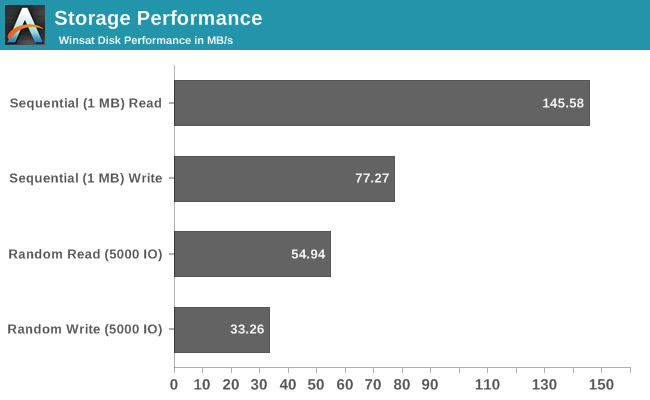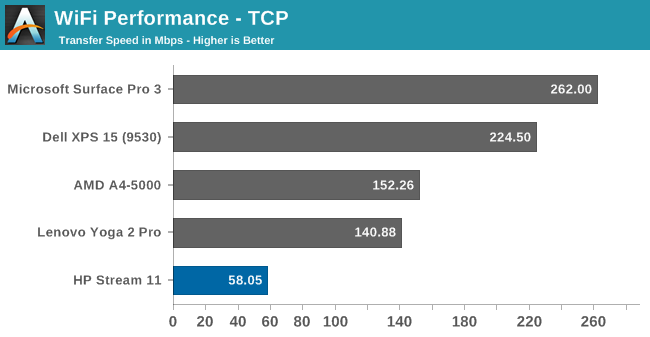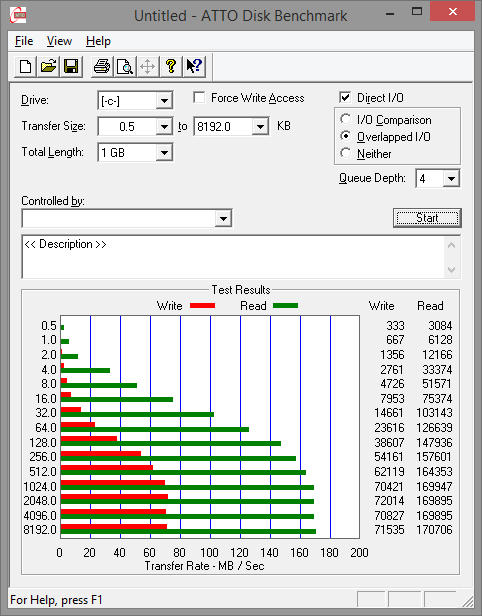HP Stream 11 Review: A New Take On Low Cost Computing
by Brett Howse on December 17, 2014 8:00 AM ESTStorage Performance
The HP Stream 11 has 32GB of eMMC based flash storage, which shows as Hynix HBG4e. It is also the first device I have seen which leverages WIMBoot, which arrived at Microsoft's Build conference as part of Windows 8.1 Update to lower the storage requirements for Windows PCs. Traditionally, PCs come with Windows installed on the C: drive, and include a recovery partition to allow people to reset or refresh their computers back to factory specifications. WIMBoot saves quite a bit of space by not actually installing all of the Windows files, but rather keeps them compressed in the WIM image on the recovery partition. This allows the actual Windows Install to only be around 4GB.
However it is not all good news. Performance will be lower, because the files will need to be uncompressed when accessed. Also, the recovery partition cannot be removed like on a normal install, so while you do save space on the actual C: drive, if the recovery partition is on the same disk, then it may take up quite a bit of room, especially if the OEM has installed a lot of software into the WIM, which they are known to do from time to time. In the case of the HP Stream 11, the amount of storage taken up by Windows and the recovery partition is about 11GB, with the recovery partition itself at 7.2GB. Out of the box, of the 32GB of eMMC available, only 17.5GB is free, and it is quickly filled to the point where you need to manage the storage. Multiple user profiles can quickly fill several GB each.
My biggest complaint about the HP Stream is the lack of storage. Doing the review, it was something that I bumped into constantly as many of the benchmarks are quite large. It does include a SD Card slot, so an extra 32GB or so there is almost a necessity, but of course having your files stored on a removable drive comes with its own risks and complications. Be sure to back them up no matter where they are.
Normally to evaluate Storage performance on laptops, we turn to Futuremark’s PCMark 8 test suite. However this requires 30GB of storage free to run the storage tests, so we can’t compare the eMMC in this device to other notebooks with SSDs using that graph.
I turned to a couple of other benchmarks to get a feel for the storage performance. Windows has some build in sequential and random read/write storage benchmarks, which resulted in these numbers:

I also used the ATTO Disk Benchmark to get a result across 1GB of storage. eMMC is not as fast as SSD, especially with small file performance. With a transfer size of 512 bytes, it would only achieve 0.32 MB/s write and 3.0 MB/s read performance, but as the transfer size increased the performance was quite good, with a maximum write of 70.3 MB/s and a maximum read of 166.7 MB/s.
Boot times are also very good, with a time from off to lock screen of around 10 seconds. The HP Stream 11’s 64-bit version of Windows also supports Connected Standby, so wake from sleep is pretty much instant. The storage performance is certainly acceptable, and I would personally take NAND over a spinning disk every time.
Wi-Fi Performance
Wireless networking is one of the first things to be cut when looking at building a budget device. Consumers may not realize that 802.11n support does not always mean the same thing, but the tick box is still checked on the specification sheet. The HP Stream 11 has taken the wireless performance to the ultimate low, implementing a Realtek RTL8923BE wireless card with Bluetooth 4.0 support. The adapter is 802.11n compatible, but with some big caveats.
Unsurprisingly, there is no 5 GHz support, but even the 2.4 GHz range only has a single stream, and only 20 MHz channel support. This gives a maximum connection speed of only 72 Mbps. Generally this is fine for web browsing, but any sort of large file transfers will be extremely painful. For testing, I keep several large files on my server that I normally just copy over the network, but with this device I found myself using a flash drive and copying them over that way.
As reviewers and consumers, we always expect the best, but with a budget this tight HP obviously found it easiest to save a few dollars on the network card. It is pretty disappointing to see this kind of performance in 2014.

Our standard Wi-Fi test only produced a result of 58.05 Mbps, which is a pretty awful result. I can excuse the lack of 5 GHz on this card, but to opt for a single channel only and on that stream to only support 20 MHz channels rather than the optional 40 MHz channels means you will be hard pressed to find worse Wi-Fi performance that still bears the 802.11n name. The standard supports up to four streams at 150 Mbps each, so one single 72 Mbps stream is not very good.











59 Comments
View All Comments
kgh00007 - Sunday, December 21, 2014 - link
I bought an Acer Aspire E 11.6 for a family member and I thinkit's basically the same platform. Celeron N2840 and 32Gb Hynix HBG4e. Overall I am impressed with how snappy the system is.The only problem is the Acer only has 9GB free, that's after uninstalling most of the bloatware. There is a separate 10GB recovery partition that Disk Management reports as being 100% free space, that cannot be deleted. Even after creating a recovery drive, there is no option to delete the recovery partition.
Does anyone have any ideas on how to recover that 10GB? It looks like Acer's implementation of WIM boot is flawed. I've found quite a few people complaining of this in the Acer forums, but no solution.
Brett Howse - Sunday, December 21, 2014 - link
When you have WIMBoot you can't remove the recovery partition because that's where the actual system files are. The flaw I see with WIMBoot (this is the first device I have reviewed which used it) are that they put too much stuff in the recovery partition - free trials to software, office, etc - and they all take up a lot of space. Since you can't remove the recovery partition it would be much better if they made it as lean as possible but depending on the OEM, it might be pretty large, negating the usefulness of it.The HP Stream was 7.2 GB because I'm pretty sure it has the full Office files in the WIM as well. Just make it a download... I'd rather download it once if I need it than take the space hit on something with such a small amount of storage. This version was the MS Signature edition though so it has less of the bloat than most, and yet it is still 7.2 GB. The Windows install I can download is ~4 GB so clearly they could do a better job with either the WIM compression or keeping extra software out and allow you to move that to a recovery USB.
kgh00007 - Sunday, December 21, 2014 - link
Cheers Brett, on the Acer the recovery partition is 10GB, but when you make a recovery drive it only uses around 7GB, so it looks like they didn't even try to optimise the size of the recovery partition, just went with 10GB!And the windows installation takes up 10GB on the drive, so there's only 9GB user accessible space left out of the box, it just seems like they wasted a lot of space.
On the stream does it actually have 17.5GB user accessible space free on the drive out of the box? The stream isn't available in Canada yet, but I might return the Acer's, I bought two of them for our mothers! They don't need a lot of space, but 9GB is cutting it fine I reckon!!
kgh00007 - Sunday, December 21, 2014 - link
UPDATE: I returned the two Acer Aspire E 11.6's for a HP Stream 11 and a Stream 13.They just came in to the local Microsoft store, so I got the signature editions and they both have 17.5GB user accessible right out of the box, much better than the 9GB in the Aceer.
Cheers Brett for the info, you helped me to make a more informed decision.
Brett Howse - Sunday, December 21, 2014 - link
Let me know what you think of them once you use them for a bit. Tweet me @BrettHowseI got this one from the MS Store in Canada so I was going to say yes you can buy them there :) Bit of a price premium over the US store but the CAD dollar has kind of tanked due to oil prices.
The 13" with touch is not yet available in Canada looks like maybe end of January for that one but you just never know.
Squinoogle - Sunday, December 28, 2014 - link
RE: Wifi - you're looking at the Envy range before you'll get anything better than 2.4GHz only 1:1 N (and even then there are still some holdouts), so I don't see them including anything better any time soon.RE: Display - Yuck, I really hope you just got a dodgy example there.
Lerianis - Tuesday, December 30, 2014 - link
I've honest got to say "Boo hiss!" to these because they are expensive compared to the E5-571-5552 from Acer. Bigger screen, more hard drive space, more RAM, more powerful CPU (Core i5) for only twice the cost of this machine.Who are you trying to fool with these articles? These machines are craptacular for what you are getting. Not even worthy 90 dollars in the real world.
avfreebird - Thursday, June 18, 2015 - link
Do you mean that when I have 200$, I (magically) get more 200$ to get a laptop for browsing, officeediting, film watching instead of this "craptacular maschine"?Pstenney - Thursday, April 28, 2016 - link
My son is having problems using flash player. Flash came preinstalled when we purchased it new Dec. 2015. Using it for school and some classes require flash. Keeps telling us that you must have flash but will not let us.